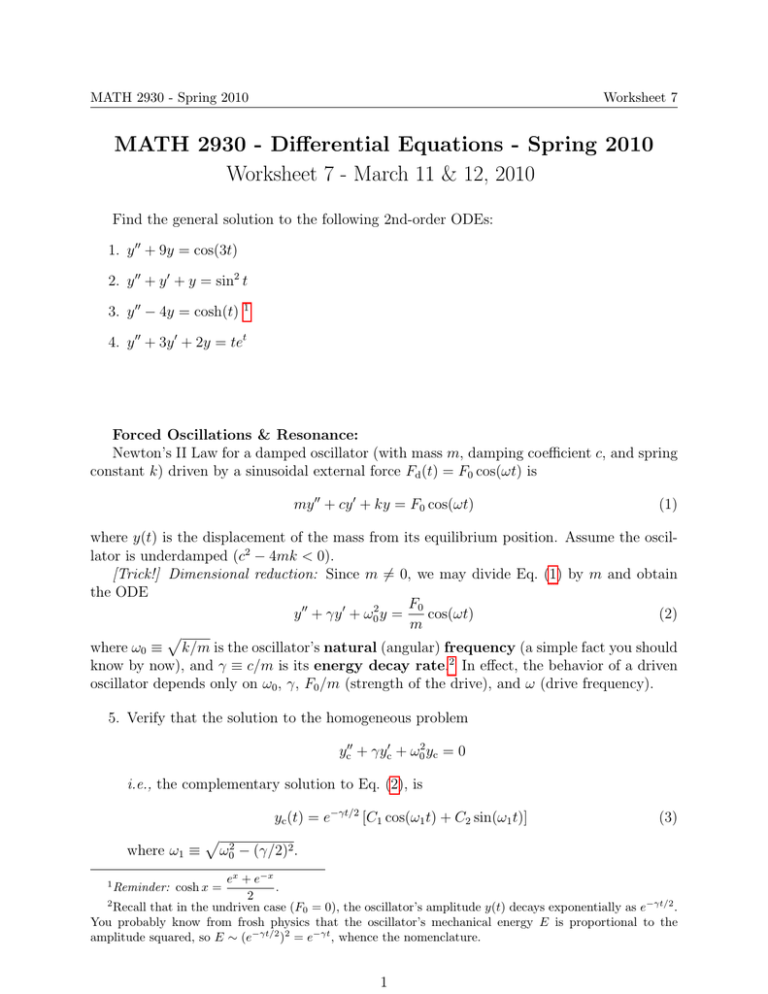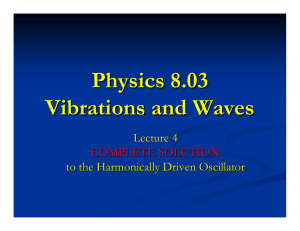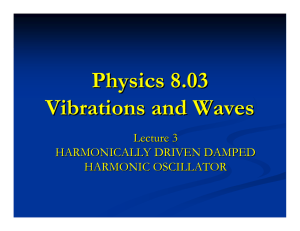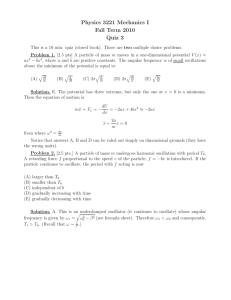MATH 2930 - Differential Equations
advertisement

MATH 2930 - Spring 2010 Worksheet 7 MATH 2930 - Differential Equations - Spring 2010 Worksheet 7 - March 11 & 12, 2010 Find the general solution to the following 2nd-order ODEs: 1. y 00 + 9y = cos(3t) 2. y 00 + y 0 + y = sin2 t 3. y 00 − 4y = cosh(t) 1 4. y 00 + 3y 0 + 2y = tet Forced Oscillations & Resonance: Newton’s II Law for a damped oscillator (with mass m, damping coefficient c, and spring constant k) driven by a sinusoidal external force Fd (t) = F0 cos(ωt) is my 00 + cy 0 + ky = F0 cos(ωt) (1) where y(t) is the displacement of the mass from its equilibrium position. Assume the oscillator is underdamped (c2 − 4mk < 0). [Trick!] Dimensional reduction: Since m 6= 0, we may divide Eq. (1) by m and obtain the ODE F0 y 00 + γy 0 + ω02 y = cos(ωt) (2) m p where ω0 ≡ k/m is the oscillator’s natural (angular) frequency (a simple fact you should know by now), and γ ≡ c/m is its energy decay rate.2 In effect, the behavior of a driven oscillator depends only on ω0 , γ, F0 /m (strength of the drive), and ω (drive frequency). 5. Verify that the solution to the homogeneous problem yc00 + γyc0 + ω02 yc = 0 i.e., the complementary solution to Eq. (2), is yc (t) = e−γt/2 [C1 cos(ω1 t) + C2 sin(ω1 t)] where ω1 ≡ (3) p ω02 − (γ/2)2 . ex + e−x . 2 2 Recall that in the undriven case (F0 = 0), the oscillator’s amplitude y(t) decays exponentially as e−γt/2 . You probably know from frosh physics that the oscillator’s mechanical energy E is proportional to the amplitude squared, so E ∼ (e−γt/2 )2 = e−γt , whence the nomenclature. 1 Reminder: cosh x = 1 MATH 2930 - Spring 2010 Worksheet 7 6. Show that a particular solution to Eq. (2) is F0 (ω02 − ω 2 ) γω cos(ωt) + 2 sin(ωt) yp (t) = m (ω 2 − ω02 )2 + (γω)2 (ω − ω02 )2 + (γω)2 (4) Rewrite yp (t) in the form R cos(ωt − φ), where R is the amplitude and φ is the phase [Recall Wed 3/11 lecture]. Sketch the amplitude R vs. the drive frequency ω. What is the (practical) resonant frequency? And (somewhat more challenging) how does the phase φ vary with ω? 7. The complete solution to Eq. (2) is y(t) = yc (t) + yp (t) where yc and yp are given by Eqs. (3) and (4). Show that for sufficiently long times (t γ −1 ), yc (t) becomes negligible compared to yp (t), so the solution y(t) is ”essentially” given by yp (t). This has a physical interpretation: physicists and engineers call yc (t) , and yp (t) the . the 8. Applet time! Go to the following URLs (linkable from pdf document) and play around with the applets. • Simulate driven harmonic oscillation: http://qbx6.ltu.edu/s_schneider/physlets/main/osc_damped_driven.shtml • Plot amplitude of yp vs. drive frequency ω: http://qbx6.ltu.edu/s_schneider/physlets/main/osc_damped_driven_amp. shtml Some suggestions for experimenting with the applets: • Choose any m and k, and c sufficiently small. Can you estimate the practical resonant frequency right away? Put your guess as the drive frequency ω, simulate, and see if you get (near-)resonance. • Next, change the drive frequency below (and, later, above) resonance. Does the behavior match your expectation? Use the 2nd applet to plot amplitude vs. drive frequency ω to get an overall picture. • Now tune ω back to practical resonance. Change the damping coefficient c. How does the (steady-state) amplitude vary with the amount of damping? 2 MATH 2930 - Spring 2010 Worksheet 7 Extra Credit3 9. Show that if the oscillator has zero damping (γ = 0) and is driven by a cosine force F0 cos(ωt), then yp (t) in Eq. (4) has only the cosine term and no sine term. In other words, the oscillator vibrates in phase with the driving force.4 10. Using dimensional analysis, show that the energy decay rate γ(≡ c/m) has the same units as frequency (i.e., inverse time). [Hint: Do dimensional analysis on Eq. (2).] 11. An important concept in physics and engineering is the use of dimensionless variables or parameters. They often tell us the intrinsic property of a system under study, or give a criterion for the regime of validity in the system’s dynamics, etc. In damped oscillators, the key dimensionless parameter is called the quality factor ω0 Q≡ γ An oscillator with higher Q will respond with a larger amplitude when on resonance. To be more precise, use Eq. (4) to show that for long enough times, the amplitude R reads F0 1 s R= 2 2 mω0 2 2 ω ω −2 −1 +Q ω0 ω0 so R= Q F F p Q ≈ 2 mω0 1 − (Q−2 /2) mω02 on (practical) resonance Thus for most purposes (Q ≥ 1), the resonant amplitude of a driven oscillator scales linearly with Q. 12. (ECE people beware!) An L(inductor)-R(resistor)-C(capacitor) circuit in series powered by a sinusoidal voltage V0 cos(ωt) can be described by the following ODE: 1 LQ00 (t) + RQ0 (t) + Q(t) = V0 cos(ωt) C where Q(t) is the charge on the capacitor.5 This has an exact correspondence with the mass-spring-dashpot problem. Exploit the correspondence to find the following parameters associated with the circuit in terms of L, R, C, as needed: • • • • the the the the natural frequency ω0 damping coefficient γ quality factor Q practical resonant frequency 3 Note: Some of these questions are drawn from Physics 2214 (Waves, Oscillations & Quantum Physics). If you (have to) take this course in the future, these give a glimpse of the problems you’ll see during the first 2 weeks. 4 In a sense, the 90◦ -out-of-phase term (i.e., the sine term) appearing in the oscillator’s trajectory can be attributed to the damping γ. In engineering parlance, the cosine term in Eq. (4) is called the reactive response, while the sine term is called the dissipative or resistive response. 5 Note that the ODE is written down from Kirchhoff’s Law, and I(t) = Q0 (t) is the current of the circuit. 3






